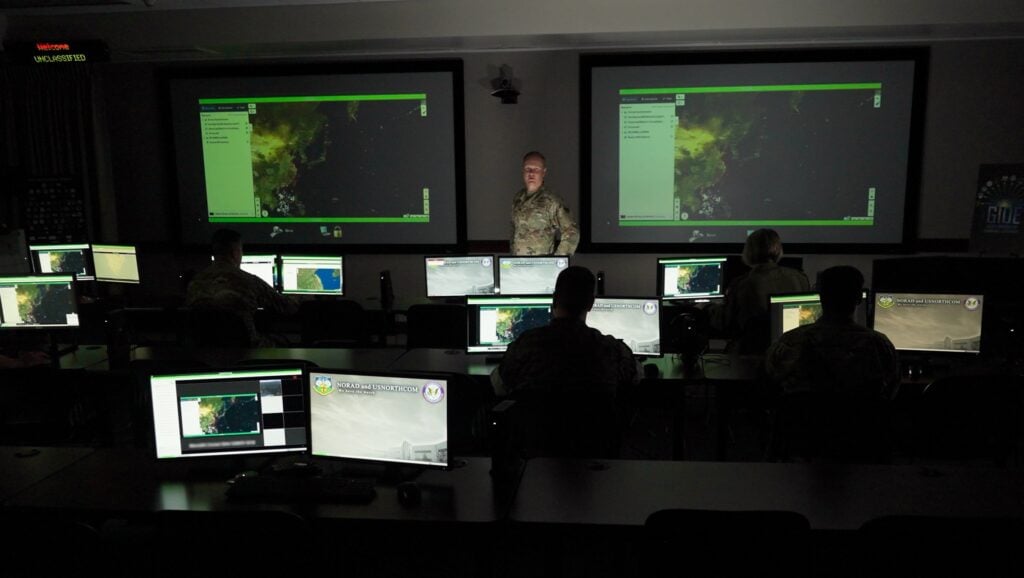
NORTHCOM’s Global Information Dominance Experiment 3 (GIDE 3) testing AI decision aids for commanders ran from July 8-15
WASHINGTON: Without artificial intelligence and machine learning tools, the Pentagon’s ambitious Joint All Domain Command and Control (JADC2) initiative simply will not be doable, according to Space Force and industry officials.
Brig. Gen. John Olsen, mobilization assistant to Space Force chief Gen. Jay Raymond, told a panel last week during the American Institute of Aeronautics and Astronautics’s ASCEND space conference that the JADC2 concept involves multiple networks around the globe in order to prosecute modern warfare in all domains, and that the human users are going to need some automated help.
“When we look at those kill chains — or when we look at the time to sense, makes sense, and act — those ‘observe, orient, decide, act or OODA Loop timelines become so compressed in the modern environment,” he said. “So, artificial intelligence and machine learning are absolutely essential enablers to make us able to react, and respond, and again, make sense of the information then act upon it.”
Seth Harvey, CEO and co-founder of Colorado startup Bluestaq, told the panel that the Space Force’s Unified Data Library (UDL) alone “consumes hundreds of millions of records a day, and we’re just scratching the surface of what data is available.” Therefore, he said, AI/ML software is a must “to help prune the data” for users.
The UDL is one of Space Force’s primary contributions to JADC2 as a repository of data from space sensors and increasingly sensors deployed in other domains as well. The Space Force awarded Bluestaq a $280 million contract extension in March for development and data integration into the UDL. Bluestaq initially helped Air Force Space Command conceptualize the UDL in 2018; it won a follow-up award to start building the data library in 2019.
“As we look at JADC2, there’s going to be there’s a compendium of decisions that can occur,” Harvey added. “Some are benign, some that are more critical in nature that put humans at risk.”
AI will be “really valuable” for taking over those benign, day-to-day chores like tasking sensors integrated into the JADC2 construct, he said. When human life is at stake, on the other hand, AI will instead become a tool to “prune the information and make it available to the decision maker.”
In fact, Northern Command back in March used its Global Information Dominance Experiments to test three AI “decision aids” designed to speed commanders’ ability to act. The AI algorithms will enable all-domain situational awareness, “information dominance,” and real-time “cross-Combatant Command collaboration,” Col. Matt “Nomad” Strohmeyer, at the time NORAD/USNORTHCOM J8 JADC2 development lead, told Breaking Defense in an exclusive interview.
While AI/ML are keys to Space Force’s ability to implement JADC2, Robbie Robinson, lead space experimentalist at Air Force Research Laboratory (AFRL), said the service has it a bit easier than its sisters services in deploying such algorithms. That’s because Kepler’s laws of planetary motion constrain what can and cannot be done in space, whereas in the other domains of air, land and sea the set of possible options for action are much larger.
“Kepler is our friend when it comes to AI,” he said. “It makes it a little easier for us to train our sets and understand intentions and capabilities.”
That may change a bit when the Space Force seriously turns its sights to cislunar operations, such as space domain awareness beyond Geosynchronous Orbit, Robinson noted.
“I think it’s going to be interesting to see what happens with those AI tools when when we start getting data beyond the GEO belt, and how we’re going to have to retrain those tools and get them to work,” he said.






















